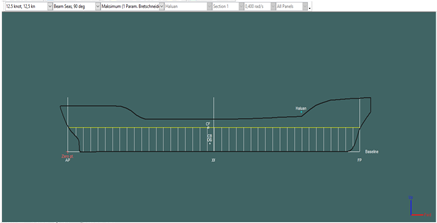Analysis of Seakeeping And Motion Sickness Incidence (MSI) Prediction Of The Ship's Bow When Sailing In Cilacap Sea
Main Article Content
Abstract
The waves are quite large, and the ship's movement continues to be a barrier tossed about or up and down on the high seas. It can result in symptoms of illness or an uncomfortable atmosphere for passengers on board. This symptom is often referred to as seasickness or motion sickness. The main cause of seasickness is the absence of similarity of excitability or conformity between the stimulus, eye and ear labyrinth the human brain receives. Usually, people who get seasick are on closed decks because their eyes cannot see any movement. At the same time, the ear labyrinth responds to the ship's movement so that there is a conflict between the stimuli received by the eyes and the ear labyrinth, which is responsible for body balance, causing nausea. In severe cases, passengers or crew must be taken to the hospital. Modelling MSI on Finite Element Method Software, it can be seen that passengers experience ship sickness or, in this case, experience MSI at what time on a cruise on the Cilacap sea lane processed to determine the condition of the ship's MSI to passengers by the acquisition of 6 degrees of freedom where various components that affect such as wind, the main current is a wave it occurs 6 degrees of freedom, i.e. Surging is a translational movement along the X axis, Rolling is the movement of the ship around the X axis, Swaying is the translational movement of the ship that occurs when the ship moves along the Y axis, Pitching is the movement of the ship around the Y axis, Heaving is the movement of the ship along the Z axis. A ship with a speed of 12.5 knots sailing in the Cilacap sea with a wave height reaching an average wave of 2.5 meters, the MSI of the ship occurs, namely the effect of sea conditions on the movement of the ship indicating that the ship's response to the sea is at 90 degrees. In the opposite direction of the wave, MSI occurs in 20% of passengers after 2 hours on the vehicle deck at the bow point. At that time, the magnitude of the encounter frequency was 2.137 Hz.
Downloads
Article Details

This work is licensed under a Creative Commons Attribution 4.0 International License.
References
H. Rudiyansah, A. Sulisetyono, and B. Ali, "Analysis of the Effect of Seakeeping on Performance and Comfort of Ro-Pax Ships Based on Model Tests in Java Sea Waters," J. Tek. POMITS, vol. 2, no. 1, pp. 1–6, 2013.
Sailors Info, “monitoring the movement of SundaStraitships,”2019.https://infopelaut.co/monitoring-pergerak-kapal-selat-sunda/.
M. Santoso, TP Kapal, P. Perkapalan, N. Surabaya, and I. Abstract, "Analysis of Motion Sickness Incidence (Msi) Prediction on a 1000 Gt Catamaran Ship in the Initial Design Phase," Kapal J. Knowledge Science. and Technol. To the sea. vol. 12, no. 1, pp. 42–49, 2015, [Online].Available:https://ejournal.undip.ac.id/index.php/kapal/article/view/8346.
Putra, DP, et al. "Seakeeping Analysis and Prediction of Motion Sickness Incidence (Msi) on a 500 Dwt Pioneer Ship in the Initial Design Stage". Journal of Marine Engineering., vol.4, No.3 July 2016.
Lestari, KP, The Potential of Cilacap Waters is Great Capital for the Development of the Minapolitan Area, 2010.
H. Palippui, “Analysis Of The Installation Of Subsea Pipelines To Support The Need For Clean Water In Supporting Tourism Development On Kayangan Island”, Maritime Park, vol. 1, no. 1, pp. 9-18, Feb. 2022.
Jensen, F. V., & Saremi, S. Seakeeping analysis for high-speed ships in irregular waves. Journal of Marine Science and Technology, 20(2), 162-174, (2015).
Manolas, D., & Spanos, D. An Investigation of Motion Sickness Incidence Prediction Criteria for Maritime Applications. The Journal of Navigation, 60(2), 255-269, (2007).
Krishnamoorthy, C. S., & Suja, R. A Comprehensive Review on Ship Seakeeping. International Journal of Engineering Research and Technology, 11(2), 269-274, (2018).

